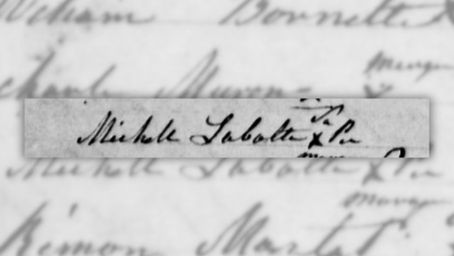top of page
Search


Elizabeth Longlade’s Keen Métis Memory
Born in 1847, Elizabeth Longlade (née Dusome) was a proud Métis matriarch whose strength and personality shone through in the everyday moments of her life. Her story, shared in a 1942 interview with the Toronto Star , captures her memories, determination, and independence. Elizabeth married Charles Longlade in Penetanguishene in 1866, 76 years prior to the article's publication. Together, they built a life rooted in family and hard work. For decades, Elizabeth worked alongsid


1850 Métis Petitioners: Michael Labatte
In 1850, the Métis community at Sault Ste. Marie stood together to protect their River Lots from settler encroachment, following the Robinson-Huron Treaty, by signing the 1850 Sault Ste. Marie Métis Petition. Michel (Michael) Labatte was among the 1850 Sault Ste. Marie Métis Petition’s signatories, on behalf of his Métis River Lot family. Born in 1814 on the American side of Sault Ste. Marie, Michael was the son of Métis War of 1812 veteran Louis George Labatte and Louisa Cad


1850 Métis Petitioners: The Boissonneau Family
In 1850, the Métis of Sault Ste. Marie petitioned the Crown for the recognition and protection of their River Lots on the St. Marys River following their exclusion from the Robinson-Huron Treaty. The 1850 Sault Ste. Marie Métis Petition was signed by members of numerous prominent Métis families in the area, including the Biron, Cadotte, Lesage, Nolin, Sayer, and Labatte families. Seven members of the Métis Boissonneau family were also among the 1850 Petition’s fifty-five sign


Canada’s Broken River Lot Promises to the Sault Métis Community
In the autumn of 1850, government-appointed Treaty Commissioner William B. Robinson, made a promise on behalf of the Crown that the lands on which the Sault Ste. Marie Métis Community resided on along the St. Mary’s River would be respected and protected. These Métis lands were organized into narrow family river lots; a pattern recognizable throughout the Métis Nation Homeland, and shared by other Métis communities including Batoche, the Red River, and St. Albert. These Métis


“An inheritance in the country equal to our own”
The Métis and Anishinaabe communities of Sault Ste. Marie have been long-time allies. Perhaps the most notable example of allyship between the two political groups occurred both during and after the Mica Bay Incident—one of the most important moments in the history of Crown-Indigenous relations in the Upper Great Lakes. Following their collective action at Mica Bay alongside their Métis allies, the Anishinaabek Chiefs Shingwaukonse-ibun and Nebainagoching-ibun advocated f


Mica Bay Pt. 5: Métis Displacement
Following their exclusion from the 1850 Robinson-Huron Treaty and despite Treaty Commissioner Robinson’s recognition that the Métis were in “free and full possession” of their lands, the Sault Ste. Marie Métis Community’s families found themselves without government-recognized title and were forced to relocate from their River Lot homes. Over the next decade, town sites at Sault Ste. Marie were opened to Ontario settlers. As a result, by 1861, Sault Ste. Marie was swamped by
bottom of page
